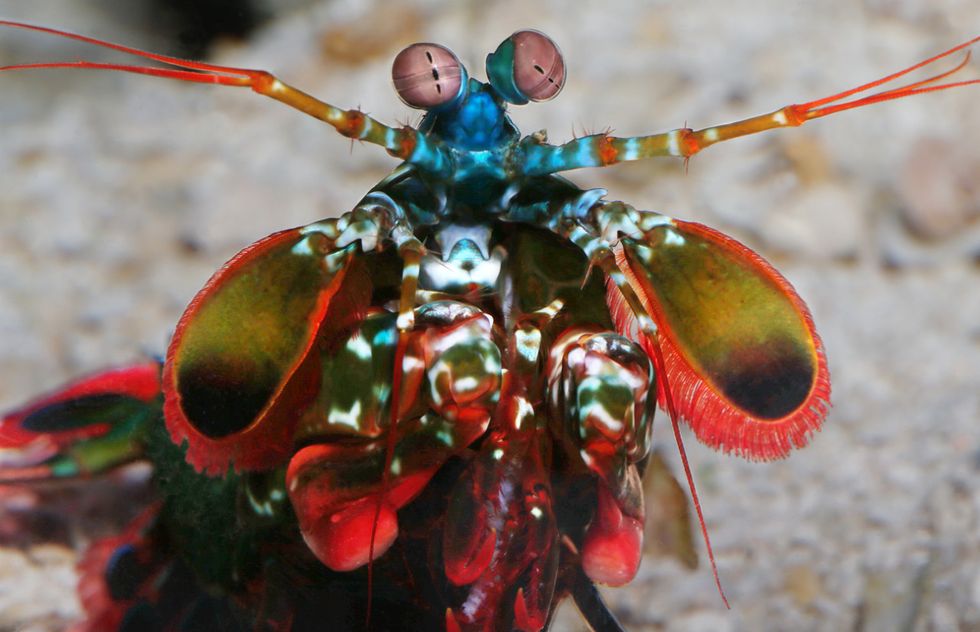Have you heard the saying “Big things come in small packages”? You may have used it many times on friends and sometimes even on objects, but finally be prepared to use it on a crustacean! If you have not heard about these creatures already, let me formally introduce you to this rainbow-like spectacle: the Mantis Shrimp.
Before delving into the revolutionary aspects of this organism, we should understand its place and uniqueness in the animal kingdom. According to Oceana, the peacock mantis shrimp’s punch is one of the fastest movements in the animal kingdom. To be more exact, the article explains their punch being “strong enough to break an aquarium wall.” For all of you who need a more quantitative description, the mantis shrimps’ punch has a speed equivalent to a 0.22 caliber bullet, which is apparently 50 times faster than the blink of an eye. In the tropical waters of the Western Pacific and the Indian Ocean, they can often time be found using this trait to break open snails, and have been known to completely disjoint crabs, shrimps, and other crustaceans.
In addition to extremely powerful legs, the mantis shrimp seem to have very peculiar eyes. Do not be fooled by its cuteness; there is definitely more than meets the “eye”! The National Aquarium mentions that the crustacean has one of the most complex eye structures in the animal kingdom. It has 16 color-receptor cones, while humans only have three. Essentially, these creatures can see parts of the Electromagnetic spectrum that we cannot even see, such as seeing in the range of ultraviolet light! Each eye can move independently and they can use this impeccable feature to detect predators and prey. These could be some of the reasons why the species is not threatened with over 400 other species of it still existing worldwide.
With these aspects of this unique creature, researchers have embarked on this journey to explore the various facets of this organism. Let us start with the powerful punch. The Patek Lab, in Duke University, is studying the various aspects of the mantis shrimp. As aforementioned, the limbs of the mantis shrimp are among the strongest and highest in speed. In their research, they have mentioned that the mantis shrimp has the potential to create cavitation bubbles when they strike their prey. Cavitation is when water vapor bubbles collapse creating a small implosion in in the water exerting heat, light, and sound. They compared this phenomenon to what happens when a rapidly rotating boat propels forward. Their movement more quantitatively boils down to peak forces of 1500N, which is 2500 times the animal’s body weight. Their “punch” can give insight into the evolution of fast movements and force generation in aquatic environments. Perhaps this aquatic attribute can give insight into the creating stronger artillery for the military perhaps on a smaller scale and also expand our knowledge of developing ultra-strong and durable material.
Everyone, say “eye”! Along with its legs, the eyes are the next most peculiar trait on the mantis shrimp. Since the eyes have 16 color receptors, some scientists are researching its uses for cancer detection. A group, co-led by Viktor Gruev in the University of Illinois Urbana-Champlain, is currently striving to achieve imaging technology inspired mantis shrimp to detect polarized light. The reason behind developing this kind of camera is so that cancer surgeons can have a visual aid to see the margins of tumors that need to be removed.
Additionally, these eye sensors have a way of analyzing the angle of a light wave, which is something the human eye is incapable of doing. Therefore, they can detect differences in areas where polarized light exists and where it does not. The polarized light that these creatures can perceive, also known as circular polarized light, is what makes 3D glasses and DVD technology to work. Cancer cells are highly proliferating cells that eventually disorganize cell tissue, so the resulting structural differences can be detected under polarized light. Moreover, these differences can occur during an earlier onset within cancer patients, which means that this can be an early detection method.
Fortunately, the scientific community has not yet caused strife in the current research developments of the mantis shrimp since it is fairly new. There are some ethical concerns in the way the shrimp acquired for research, but other than that there has not been much debate.
We can truly conclude the big things do come in small packages. Research with this organism has only touched the tip of the iceberg. There is much more to uncover about the shrimp and some of its features for our own practical uses. The depths of our oceans hold some of the greatest power, and there is so much more left to uncover or in this shrimp’s case, dismantle.

















